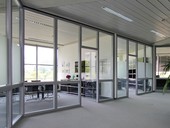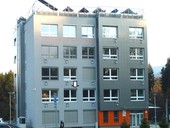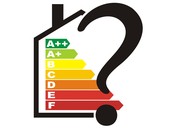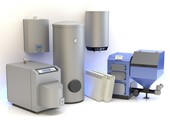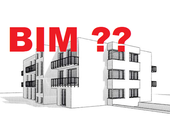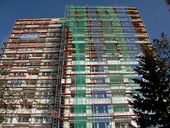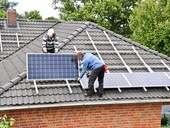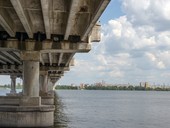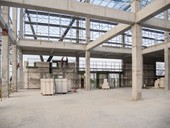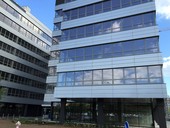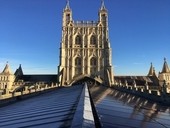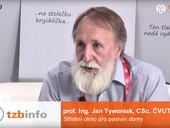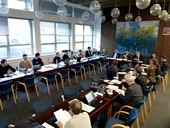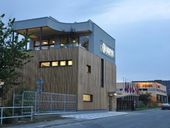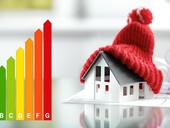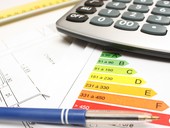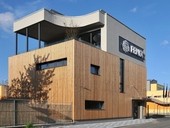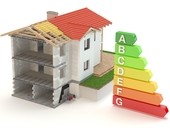Increasing the thermal insulation properties of walls, roofs, floors and windows has a positive effect on reducing heat loss and energy need for heating. However, when assessing the energy need for cooling in buildings with conditioned indoor environment, this tendency to increase the thermal insulation capability may lead to an increase the energy need for cooling, when measures to reduce heat gains by transparent structures are not applied.
Archiv článků od 10.9.2018 do 22.10.2019
In the contribution, we are focused on the quality of the heat-moisture microclimate and the aspects that affect it. We chose one office room in the building of the Research Center of the University of Žilina (UNIZA), oriented to the west. The subject of the measurements were all physical components of the indoor environment, the effect of solar radiation through window constructions and floor temperatures using low-temperature radiant floor heating. The contribution describes measuring methods, results of measurements and related partial conclusions for cold climatic conditions of the year.
The paper deals with the comparison of real energy consumption with values calculated in the Energy Performance Certificate (PENB) for two buildings: New low-energy family house and older apartment building. In both cases, these are wooden buildings. Subsequently, basic differences between the card and the reality in terms of energy consumption are defined in the form of house use coefficients.
The authors answer the question how to choose a heat source for a family house built with respect to the current thermal technical requirements. An example is new building of a two-storey family house approximately 20 km south of Brno with a residential part of the house with a square plan of 11 × 11 meters. The evaluation results are compared according to five different criteria.
The article deals with BIM technology in co-operation with design of HVAC. The theme is divided into two related parts. The first part describes the complex issues related to BIM technology and its implementation in TZB practice. In the second part there is a practical way of comparing the calculation of heat losses according to CSN EN and using the BIM tool.
The paper presents results of a study on potential reduction of CO2 emissions of the Czech national building stock until 2075. The calculations were based on datasets provided by Chance for Buildings that modeled five different scenarios of energy savings in the Czech building stock that varied by the depth of the energy retrofitting measures and by the pace of their application. The results were compared to the carbon budget that was set in line with the objectives of the Paris agreement.
The current era is favorable for the expansion of renewable energy sources and their integration into the energy economy of buildings for residential or commercial use. According to the long-term statistics, buildings consume about 40 % of all energy produced. At the same time, the buildings together with the industry provide a huge potential for the installation of renewable energy sources. The article presents advantages and disadvantages of particular types of the most commonly used photovoltaic systems integrated in buildings. It describes the ways to maximize the use of the installed renewable sources, the assessment of the rate of return of the particular types of photovoltaic systems, not counting the subsidy support, and evaluation of the installation complexity (both financial and technical).
An example of reliability verification of existing concrete member represent an extension of previous authors contribution “New European document for assessment of existing structures”. The illustrative example of the member is based on the new Technical specification [2]) and valid Eorocodes ČSN EN 1990 [7] and ČSN EN 1991-1-1 [9]. The contribution should provide background information supporting implementation of the new European document on assessment of existing structures to national standards.
The upcoming CEN Technical Specification (TS) on assessment of existing structures is related to the fundamental concepts and requirements of the current generation of EN Eurocodes. The final draft of the Technical specification was already submitted to the technical committee CEN TC250 in April 2018. The document concerns all types of buildings, bridges and construction works, including geotechnical structures, exposed to all kinds of actions. It contains requirements, general framework of assessment, data updating, structural analysis, different verification methods (partial factors, probabilistic methods, risk assessment), interventions, heritage building. The submitted contribution provides background information on the principles accepted in the final draft of TS and practical examples of applications of existing structures including panel buildings.
Paper deals with the definition of energy flexible building, its impact on the stability of the grid with the planned increasing share of energy from renewable sources and the possibility of using the heat storage capacity of building structures. Paper further analyzes the selected methodology for evaluation of the energy flexibible building and gives an example of thermally activated building structures.
Historic buildings are often classified as highly energy-intensive buildings with low energy efficiency. Thanks to their overall percentage share in the European real estate market, it is logical to focus on these objects with an innovative approach and functional, sensitively aesthetic solutions, thus significantly reducing their energy intensity and increasing their energy efficiency. At the same time, it will enable to meet the new energy targets currently proposed by the European Commission.
The article describes basic principles of the SBToolCZ green building assessment methodology stressing its up-to-date methods for school buildings. An example of a certified school is given. Renovation of this school was assessed and optimised by the SBToolCZ system which lead to the conversion into intelligent, zero energy building.
The paper presents the building-physical context of the use of roof windows in buildings with very low energy demand. It shows their relatively significant influence on the total heat loss of a single family house and the consequence of the specific disadvantageous set-up in the pitched roof. It is shown that the thermal transmittance should not exceed 0.7 W/(m2K) with a strict limitation of thermal coupling in the connection to the roof. In the second part, the paper shows the positive effect of the slanting of the inner lining on the quality of day lighting.
Virtual models of spaces, devices, humans, and their interconnectedness with mathematical descriptions of the interactions between them allow for shorter time in finding the optimal variation. Many processes are neither realistically traceable at the micro level, and can be derived only on the basis of the consistency of simulations and real measurements at the macro level. The TZB area offers a wide range of computer simulations, as lectures at the conference.
In July 2018, a two-year monitoring of the FENIX Group a.s. in Jeseník. During this time, different battery operating modes were applied to test their capabilities to ensure the power operation of the object. This article describes the entire period in terms of energy flows in the building. The key parameters are energy consumption, supply to the grid, self-sufficiency of the building from the photovoltaic source and its local use. A number of articles have been written about the building, detailing the building and energy aspects [1, 2]. Therefore, the description of the energy economy in the building will be given only to the extent necessary for a general view of the building's energy.
The methodology for determining energy-neutral or energy-zero houses is different at national levels. The interest in the realization of such houses is not only influenced by the methodology but also by the market conditions in the area of moving surplus energy production from one object to another. This is an economically disadvantageous purchase price when delivering to the network. If the existing conditions in the Czech Republic are not changed, the implementation of energy-zero houses for investors will not be interesting and the potential for reduction of CO2 production will not be utilized.
The methodology for determining energy-neutral or energy-zero houses is different at national levels. The interest in the realization of such houses is not only influenced by the methodology but also by the market conditions in the area of moving surplus energy production from one object to another. This is an economically disadvantageous purchase price when delivering to the network. If the existing conditions in the Czech Republic are not changed, the implementation of energy-zero houses for investors will not be interesting and the potential for reduction of CO2 production will not be utilized.
The article contains a summary of energy consumption, a comparison with the calculation assumptions in a particular administrative building. The object is designed with minimal energy consumption and the goal is to achieve the highest degree of energy independence using photovoltaics and battery storage. The actual course of measured energy consumption, the overall assessment for the past period, the monthly summaries for the building as a whole and the individual sub-measured energy consumption are given. The aim is to bring the issue to the professional public and to indicate the path to the solution.
The notion of a nearly zero building, usually NZEB or nZEB, is no longer a novelty. This energy standard was introduced in 2016 and is gradually expanding into family houses. There are legislation, standards, but little has been gained. That's why the authors analyzed 130 already existing family houses with different heat sources. The result is an assessment of the influence of different heat sources on the energy intensity of homes and therefore an orientation aid for decision-makers of future builders.
zpět na aktuální články
